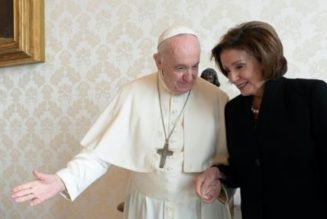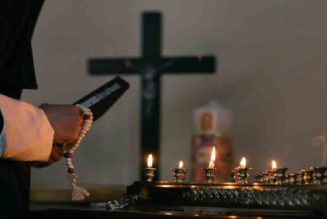 |
Without presuming to speak for the human race, but claiming what authority membership bestows, let it be said that there is no time when people are more susceptible to otherworldly interactions than at Christmas time. Marking the greatest spiritual Advent in history, the aura and traditions of Christmas have been alive with spirits ever since the Star danced over Bethlehem. Father Christmas—Santa Claus—will always live as the eternal Spirit of Christmas; he is the quiet ghost that will cheerily haunt every chimney corner on every Christmas Eve.
Sadly, many parents reject Santa Claus as a lie, relinquishing their traditional league famously described in Dr. Moore’s poem “A Visit from Saint Nicholas.” But Santa Claus must be believed in, as a truth enacting the Christmastide interplay of man and God. Santa Claus is one of those invisible powers of tremendous consequence that move among men, conjoining the secular to the sacred in a holy and humane balance. Though many men may fail to believe, Santa Claus is very real indeed.
1. Santa Claus is real.
A long time ago, away back in the fourth century, there was a bishop in Myra (now Asia Minor) named Nicholas. He was a feisty man, tall and lean, who loved the Lord. Ever the watchful shepherd, he took a swing at the heretic Arius at the Council of Nicaea and forced fistfuls of money through the windows of the poor under cover of darkness. After he died, Nicholas went to heaven, and there he is to this day.
Saint Nicholas was venerated on December 6 throughout the Middle Ages, especially in Russia and Greece. In Holland, Dutch children learned to put their shoes by the fireplace on Christmas Eve, along with some food for Sinterklass, who would certainly be near on his white horse, flying from rooftop to rooftop, popping candy down the chimneys. And who is to say he didn’t—or doesn’t? Just because Saint Nicholas is dead doesn’t mean he isn’t alive. On the contrary, life only truly begins after death—and what business Saint Nicholas has at hand on Christmas Eve can only be wondered at, but not denied.
2. Santa Claus is true.
It is proper to believe in things true and truthful, and it is proper to believe in Santa Claus because he is both, representing and participating in those unseen powers that are a part of life—the most important part of life, in fact. Unfortunately, it is not unusual for Catholic parents not to “do” Santa Claus with their children on account of the earthward shift in the paradigms of the modern Christmas season.
Those things that the world parodies, however, are very often the very things worth protecting. Parents who bolster a belief in Santa Claus are not lying to their children, as is too often thought. Quite the opposite, they are telling them something that is deeply true, something touching on Truth itself; and as Pilate taught us, it is not always easy to know what truth is. Santa Claus is a spirit of realism that instructs and instills the sense of truth—the truth that there are more things in heaven and earth than are dreamt of in our philosophy.
3. Santa Claus is innocence and wonder.
As long as there is innocence and wonder in the world, so too will there be Santa Claus. He exemplifies these precious qualities that keep alive the sweet, simple awareness of the benevolent powers that weave through the affairs of men. The miracle of the jolly old elf who bounds or breathes down the chimney with gifts to celebrate and signify the Miraculous Gift of Christmas can only be as present as the heart allows. There is an existence that belongs to the fragments of thought and figments of imagination, and the more innocent they are, the more wondrous their manifestations. Like most miracles, it takes innocence and wonder to behold their world-widening whimsy.
Santa Claus is the child of these playful participations, and he bounces into being with all of the joy that accompanies a youthful vision, unsullied by cynicism and unencumbered by scientism. So long as there is Santa Claus, then innocence and wonder—those parents of wisdom—yet hold sway in your household.
4. Santa Claus is the invisible.
Plato told a story about two worlds—one of shadows, and the other, the land from whence the shadows fall. The Incarnation brought the shadows and their reality together, filling up the gulf between angels and shepherds, peasants and kings, man and God. And when the Light shone in the darkness, those who knew Him saw something of the invisible world for the first time. The sainted Bishop of Myra is a spirit who brings the Light into the darkness. Just because you may never have seen him doesn’t mean he doesn’t exist. Fiddlesticks! Blessed are they who do not see and yet believe.
Santa Claus is real—make no mistake—but like a great many beings we believe in, he works invisibly through visible things. Christmas morning is a time to awake to miracles that have been accomplished by unseen benefactors, who are a part of our lives and command our love. To borrow a phrase from the Fox to the Little Prince: “It is only with the heart that one can see rightly; what is essential is invisible to the eye.”
5. Santa Claus is heavenly.
There are secrets that proceed from the Incarnation, and Santa Claus is one of them. There are mysteries at work in the world that subsist in the Divine Mystery, and Santa Claus is one of them. There are strange sacramentals that bring heaven to earth, and Santa Claus is one of them. Keeping Christmas well should include the acknowledgement of otherworldly things—things that mingle heaven with earth in a reenactment of that time when heaven came down to earth.
As it stands, Christmas has been boiled down to giving and getting. Would any self-respecting Christian, however, cease to celebrate Christmas just because secular humanism had interfered with it? Furthermore, should any self-respecting Catholic let hell claim what heaven has instituted or called her own? The world has sold Santa Claus into the slavery of a Christ-less Christmas, making him an icon of Hallmark instead of heaven. His image has suffered as a result, but only because he was deemed worthy of assault—and that only because of his reality.
6. Santa Claus is liturgical.
Be attentive. The world is full of things that we do not understand, but still believe in—and these should be the source and summit of every domestic church’s creed. Keeping a liturgical rhythm, St. Nicholas comes around to every domestic church on the night before Christmas—if he is welcomed—and shares a ministry with parents. He fills all of the stockings hung by the chimney with care, and he uses the hands of mothers and fathers to do it. The central Christmas mystery is one that must involve parents, whether they are preparing stockings or swaddling clothes. Father Christmas and the Christian father are well met, as is revealed every Christmas Eve whenever toys appear beneath the tree. Though a merry canonicate, it is yet a holy one.
The familial and familiar praxes of Christmas Eve bear the tone and order of a religious rite: silence, fire, gifts, whispers, communion between the material and immaterial worlds. With benediction from father and mother, Santa Claus departs in peace upon the dismissal.
7. Santa Claus is faith-forming.
The mystical visit of Santa Claus is part of the magic of Christmas—or, if you prefer, the miracle of Christmas. In commemorating when God became Man, Christmas deals with the divine mysteries that surround us—commonly depicted as fairies, imps, and elves. Mind you, this is not to say that these creatures are simply symbolic and not real. O ye of little faith.
There is simply some disputation as to what these creatures’ exact natures are. But they are actual—even ordinary—and not simply allegorical, which is the reason why Christmas lore and tradition casually presents them as part of the household.
Santa and all of his elvish kind are as commonplace as an aunt or an uncle, and whatever they are, they are accepted as part of everyday life. It is at Christmastime, though, that their presence is more poignant; they instigate strong reflection on the fact that the supernatural is not above mingling with the natural. This truth is something to have faith in and to believe in, as a certain shoemaker and his wife can attest.
8. Santa Claus is Christlike.
The richest Christmas traditions concern down-to-earth things, which only makes sense, as they celebrate the single greatest Down-To-Earth Thing: the Word made Flesh. This is precisely why it makes sense to find heavenly hosts like the army over Bethlehem, shuddering ghosts of Christmas past like Jacob Marley, and jolly elves like Santa Claus as a part of Christmastide’s union of the ordinary and the extraordinary. It is nothing to be too surprised or alarmed about. Let us not forget that greater miracles than a holy spirit coming to human hearthsides have taken place and do take place.
We live, after all, in a world where God became Man, and where He today becomes our food and drink. The Nativity of Christ brought two realities together, and Santa Claus makes this point by reminding us of the sometimes-elvish business of salvific interaction, visiting our families suddenly in the bleak midwinter night, just as the Christ Child did.
9. Santa Claus is childlike.
There is a proverb that says if a man doesn’t read poetry when he is young, he won’t be able to pray when he is old. The poetic intuitions of childhood very often provide the practical touchstones that adulthood requires in order to remain rooted in the wondrous mystery of things.
Ironically, it takes a childlike belief to remind adults of their obligation to believe in the spirits that surround us—and especially in Santa Claus. Grown-ups are really and truly invited to participate in the secret of the saint who comes each year to banish Want and enthrone Abundance for the Twelve Days of Christmas. Saint Nicholas—the patron of children, who raised three boys back to life out of a pickling barrel—also brings men and women out of the stupor of age and back to the exciting life of childhood. Alongside our own children, we can become again like the little ones; indeed we must, if we are to enter the kingdom where Santa Claus serves.
10. Santa Claus is delightful.
It is always beautiful when delight flows from acts of piety. Saint Thomas Aquinas defined the beautiful as that which, when seen, pleases. Entering into the belief of Santa Claus by freeing one’s mind and imagination to accept that the invisible world is real, and that its agents are known to us, is an act of faith that causes delight. That delight is the result of encountering something beautiful and, as Aristotle taught, the beautiful is united with both the good and the true. Therefore, the delight imparted in believing in Santa Claus is a proof of his goodness and truth, and further, of his existence. Moreover, the delight that wells up in us when we recognize truth, goodness, and beauty, springs from a divine source.
Entering into this delightful belief, we might then share the words of Wisdom herself as she sings, “I was daily his delight, rejoicing before him always, rejoicing in his inhabited world and delighting in the sons of men.”
If you would like to receive a free illustrated booklet featuring this text, click here.
Join Our Telegram Group : Salvation & Prosperity










